
Florida has many different kinds of doves, and each one is special and beautiful in its way. These gentle birds are a wonderful thing to see in your backyard, and they remind us of the calm and peacefulness of nature.
In this blog post, we will talk about the different types of doves that live in Florida. We will learn about what they do and where they live, their diet, habitat, and many more.
So, if you like watching birds or just seeing animals in your backyard, this blog post is perfect for you!
Types of Doves in Florida
You can spot 10 types of doves in Florida. Some of them are rare and common and some species are season visitors. From Key West quail-dove to Rock dove all species of doves you can spot in Florida. Here is the list:
- Key West quail-dove
- Ruddy quail-dove
- Mourning Dove
- Common Ground-Dove
- Eurasian Collared-Dove
- Inca Dove
- Zenaida Dove
- White-winged Dove
- White-crowned Pigeon
- Rock Pigeon
Now, let’s explore their appearance, color, habitat, sound, behavior, food, etc.
1. Key West Quail-dove
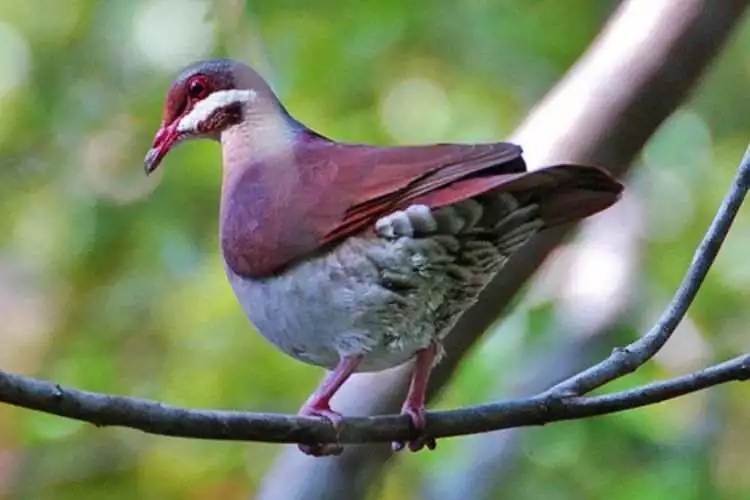
The Key West Quail-Dove is a type of dove found only on Key West Island in Florida. It can grow up to 8.7 to 9.8 inches long. It has a plump body, rounded head, and short tail.
Here is a very informative table about this dove species.
| Aspect | Information |
|---|---|
| Scientific Name | Geotrygon chrysia |
| Common Name | Key West Quail-Dove |
| Status | Near Threatened (IUCN) |
| Appearance | Small dove, reddish-brown back, grey head and chest, white facial stripe |
| Size | Length: 27-31 cm (10.6-12.2 in); Weight: 140-160 g (4.9-5.6 oz) |
| Habitat | Tropical dry forests, woodlands, shrublands |
| Range | Bahamas, Cuba, Cayman Islands; rarely in Florida Keys |
| Diet | Seeds, fruits, small invertebrates |
| Behavior | Forages on the ground, seen alone or in pairs |
| Nesting | Nests on ground or low in vegetation; simple platform nest |
| Reproduction | Lays 2 white eggs; 13-14 day incubation |
| Lifespan | Estimated 5-10 years (similar species) |
| Threats | Habitat loss, predators, human disturbance |
| Conservation | Habitat protection, invasive species control |
It has reddish-brown upperparts, cinnamon-colored underparts, and a blue-grey facial mask with a white throat patch and a thin white line above the eye.
These doves live in the pine rocklands and hardwood hammocks of Key West. They prefer areas with dense vegetation like shrubs and trees.
They are shy and often hide in the vegetation. Their low-pitched call sounds like “wooo-wooo-woo.” They mostly stay on the ground, searching for seeds, fruits, and insects.
The Key West Quail-Dove is endangered because its habitat is being destroyed by urbanization, agriculture, and invasive species.
The Key West Quail-Dove population is small and decreasing. Conservation efforts involve restoring their habitat, controlling invasive species, and raising awareness.
Related: 4 species of Doves in Michigan
2. Ruddy quail-dove
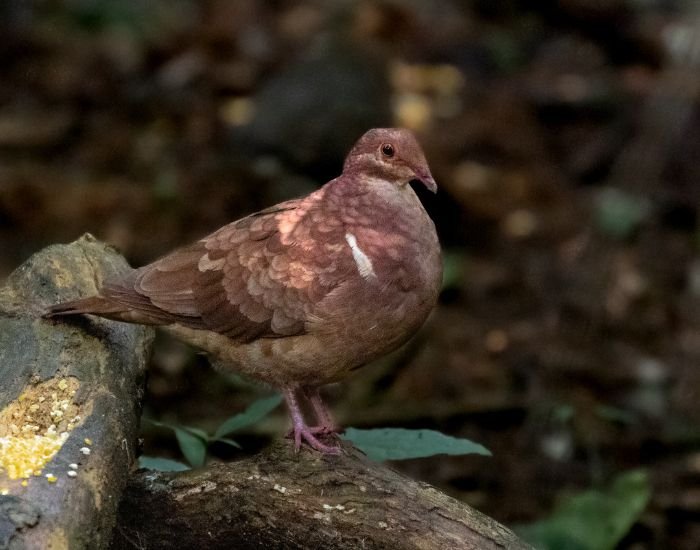
The Ruddy Quail-Dove is a medium-sized dove found in the Caribbean and some parts of Florida. It is about 10.6 inches long with a stout body, short tail, and rounded wings.
Its plumage is ruddy-brown on the head, neck, and breast, with darker back and wings. It has a red eye ring and a curved bill.
| Aspect | Information |
|---|---|
| Scientific Name | Geotrygon montana |
| Common Name | Ruddy Quail-Dove |
| Status | Least Concern (IUCN) |
| Appearance | Small dove, reddish-brown plumage, pale grey forehead, white facial stripe |
| Size | Length: 22-26 cm (8.7-10.2 in); Weight: 110-145 g (3.9-5.1 oz) |
| Habitat | Tropical forests, woodlands, and shrublands |
| Range | Mexico, Central America, South America, Caribbean |
| Diet | Seeds, fruits, small invertebrates |
| Behavior | Ground forager, typically solitary or in pairs |
| Nesting | Nests on ground or low in vegetation; simple platform nest |
| Reproduction | Lays 1-2 white eggs; 12-14 day incubation |
| Lifespan | Estimated 5-10 years (similar species) |
| Threats | Habitat loss, predation by invasive species |
| Conservation | Habitat protection, conservation efforts |
Ruddy Quail-Doves live in forests, including tropical and subtropical ones. They prefer lowland areas and mountains.
They are also shy like Key West Quail-dove and mostly stay on the ground or perch in trees. They eat seeds, fruits, and insects.
These doves are found in various Caribbean islands and southern Florida, particularly in the Everglades and the Florida Keys.
The Ruddy Quail-Dove is not currently considered globally threatened or endangered. However, habitat loss and deforestation can impact their populations.
Related: Doves in Alabama
3. Mourning Dove
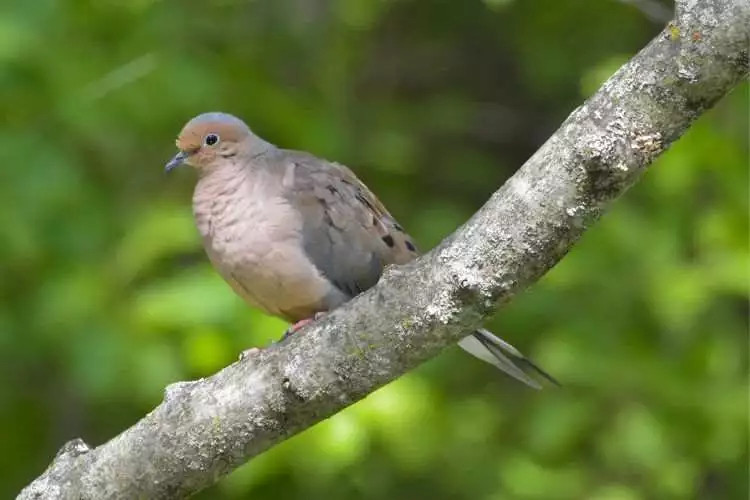
The Mourning Dove is a common bird in North America. Mourning Doves have a slim bodies, long tails, and grey-brown feathers with black spots on their wings.
| Aspect | Information |
|---|---|
| Scientific Name | Zenaida macroura |
| Common Name | Mourning Dove |
| Status | Least Concern (IUCN) |
| Appearance | Slender, greyish-brown body, long pointed tail, black spots on wings |
| Size | Length: 23-34 cm (9.1-13.4 in); Weight: 112-170 g (4.0-6.0 oz) |
| Habitat | Open and semi-open areas, including urban areas, farms, and grasslands |
| Range | Throughout North America, parts of Central America and the Caribbean |
| Diet | Seeds, grains, occasionally insects |
| Behavior | Ground forager, often seen in flocks |
| Nesting | Nests in trees, shrubs, or on buildings; flimsy platform nest |
| Reproduction | Lays 2 white eggs; 14-day incubation |
| Lifespan | Typically 1.5 years in the wild, but can live up to 5-7 years |
| Threats | Predation, habitat loss, hunting |
| Conservation | Stable population, benefits from habitat conservation efforts |
They live in cities, forests, fields, and deserts, preferring areas with some trees. Mourning Doves are the most commonly seen doves in Arizona.
Mourning Doves make soft cooing sounds. They eat seeds, grains, and sometimes insects. They drink water by sucking it up.
They’re found throughout North America. Some migrate, while others stay in one place all year.
Mourning Doves are not endangered. They’re abundant and widespread. Mourning Doves are common birds that you can often see and hear in different places.
4. Common Ground-Dove

The Common Ground is a small bird that is mostly found in the Americas including Florida. Here is a full table about this bird –
| Aspect | Information |
|---|---|
| Scientific Name | Zenaida macroura |
| Common Name | Mourning Dove |
| Status | Least Concern (IUCN) |
| Appearance | Slender, greyish-brown body, long pointed tail, black spots on wings |
| Size | Length: 23-34 cm (9.1-13.4 in); Weight: 112-170 g (4.0-6.0 oz) |
| Habitat | Open and semi-open areas, including urban areas, farms, and grasslands |
| Range | Throughout North America, parts of Central America and the Caribbean |
| Diet | Seeds, grains, occasionally insects |
| Behavior | Ground forager, often seen in flocks |
| Nesting | Nests in trees, shrubs, or on buildings; flimsy platform nest |
| Reproduction | Lays 2 white eggs; 14-day incubation |
| Lifespan | Typically 1.5 years in the wild, but can live up to 5-7 years |
| Threats | Predation, habitat loss, hunting |
| Conservation | Stable population, benefits from habitat conservation efforts |
They have greyish-brown feathers with a blue-grey face and reddish-brown or pinkish patches on their wings.
They live in open areas like grasslands, fields, and parks, and they walk or run on the ground.
Common Ground Doves eat seeds, grains, and small insects.
They can be found from the southern United States to South America, including Mexico and Central America.
They are not endangered and are adaptable to different environments.
5. Eurasian Collared-Dove
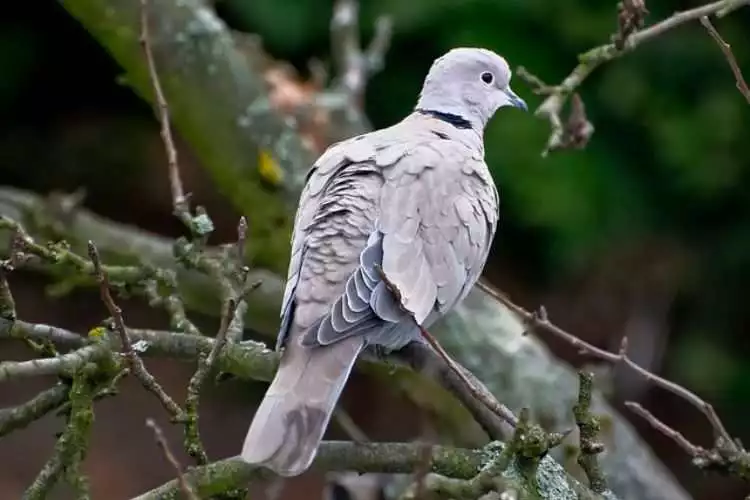
The Eurasian collared dove is a medium-sized bird found in Florida, and other places in Europe, Asia, and other parts of the world. You can also find these types of doves in Michigan.
| Aspect | Information |
|---|---|
| Scientific Name | Streptopelia decaocto |
| Common Name | Eurasian Collared-Dove |
| Status | Least Concern (IUCN) |
| Appearance | Pale grey body, black crescent-shaped collar on the neck, white-tipped tail |
| Size | Length: 32-34 cm (12.6-13.4 in); Weight: 150-260 g (5.3-9.2 oz) |
| Habitat | Urban areas, farmlands, woodlands |
| Range | Native to Europe and Asia; introduced to North America and other regions |
| Diet | Seeds, grains, some fruits |
| Behavior | Often seen in pairs or small flocks, ground forager |
| Nesting | Nests in trees, buildings, or other structures; simple platform nest |
| Reproduction | Lays 2 white eggs; 14-18 day incubation |
| Lifespan | Typically 3-5 years in the wild, up to 13 years in captivity |
| Threats | Predation, competition with native species |
| Conservation | Stable population, widespread and adaptable |
Eurasian Collared-Doves have plump bodies, long tails, and greyish or light brown feathers. They have a black collar on their neck and reddish eyes.
They can live in different places like cities, farms, forests, and gardens. They are adaptable birds.
Eurasian Collared-Doves make soft cooing sounds and eat seeds, grains, and fruits. They often perch on power lines or trees.
Eurasian collared doves are not endangered. They have successfully established populations in various regions.
Eurasian collared doves are common birds that you may see in different habitats. They have a distinctive appearance and their cooing calls are often heard.
6. Inca Dove
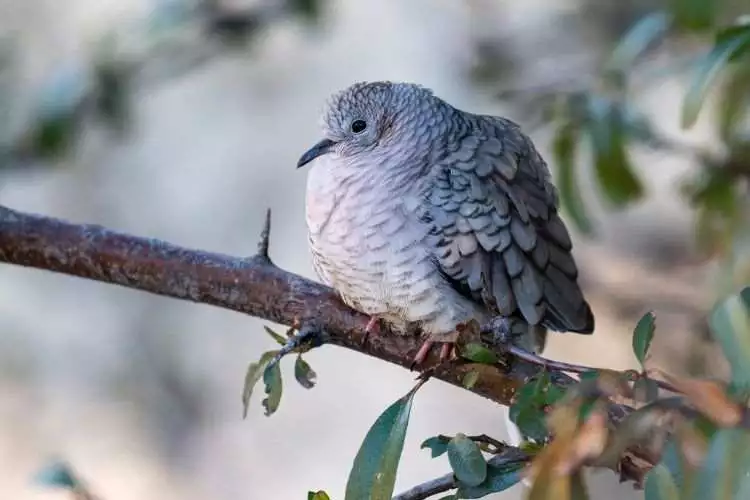
The Inca Dove is a small bird found in the southwestern United States including Florida, Mexico, and Central America.
| Aspect | Information |
|---|---|
| Scientific Name | Columbina inca |
| Common Name | Inca Dove |
| Status | Least Concern (IUCN) |
| Appearance | Small dove, brownish-grey plumage with a scaly appearance, long tail |
| Size | Length: 16.5-23 cm (6.5-9.1 in); Weight: 30-58 g (1.1-2.0 oz) |
| Habitat | Urban areas, gardens, open woodlands, deserts |
| Range | Southwestern United States, Mexico, Central America |
| Diet | Seeds, grains, occasionally small insects |
| Behavior | Ground forager, often seen in pairs or small groups |
| Nesting | Nests in trees, shrubs, or man-made structures; simple platform nest |
| Reproduction | Lays 2 white eggs; 14-day incubation |
| Lifespan | Typically 2-3 years in the wild |
| Threats | Predation, habitat loss |
| Conservation | Stable population, adaptable to urban environments |
Inca Doves are small with greyish-brown feathers, a scaly pattern on their wings, and a pale blue-grey face.
They live in dry areas like deserts, scrublands, and woodlands. They can also be seen in cities.
Inca Doves make a repetitive cooing sound and often feed on the ground in groups. They eat seeds, grains, and sometimes insects.
They are found in the southwestern United States (Arizona, New Mexico, Florida, Texas, and southern California), Mexico, and Central America.
Inca Doves are not endangered. They can adapt to different habitats.
Inca Doves are small birds that you may spot in dry regions. They have a unique appearance and make a repeating cooing sound.
7. Zenaida Dove

The Zenaida Dove is a medium-sized bird found in the Americas. This species is not a common dove in Florida.
| Aspect | Information |
|---|---|
| Scientific Name | Zenaida aurita |
| Common Name | Zenaida Dove |
| Status | Least Concern (IUCN) |
| Appearance | Brownish body, pinkish-grey head and underparts, white edges on the wings, distinctive white eye ring |
| Size | Length: 28-30 cm (11-12 in); Weight: 140-180 g (4.9-6.3 oz) |
| Habitat | Woodlands, scrub, urban areas, coastal regions |
| Range | Caribbean, including Bahamas, Greater and Lesser Antilles; also in parts of Central and South America |
| Diet | Seeds, grains, fruits, occasionally small invertebrates |
| Behavior | Ground forager, often seen alone or in pairs |
| Nesting | Nests in trees, shrubs, or on the ground; simple platform nest |
| Reproduction | Lays 2 white eggs; 13-14 day incubation |
| Lifespan | Typically 2-3 years in the wild |
| Threats | Habitat loss, predation |
| Conservation | Stable population, benefits from habitat conservation efforts |
The Zenaida Dove has a plump body with light grey-brown feathers and a pinkish chest. It can be seen in forests, woodlands, and even cities.
They make soft cooing sounds and feed on the ground, eating seeds, grains, fruits, and sometimes insects.
Zenaida Doves are found in North America, the Caribbean, Central America, and parts of South America.
They are common birds and not in danger of extinction. Zenaida Doves are medium-sized birds with grey-brown feathers.
They live in various habitats and have a gentle cooing call. They eat a variety of food and can be found in the Americas.
8. White-winged Dove
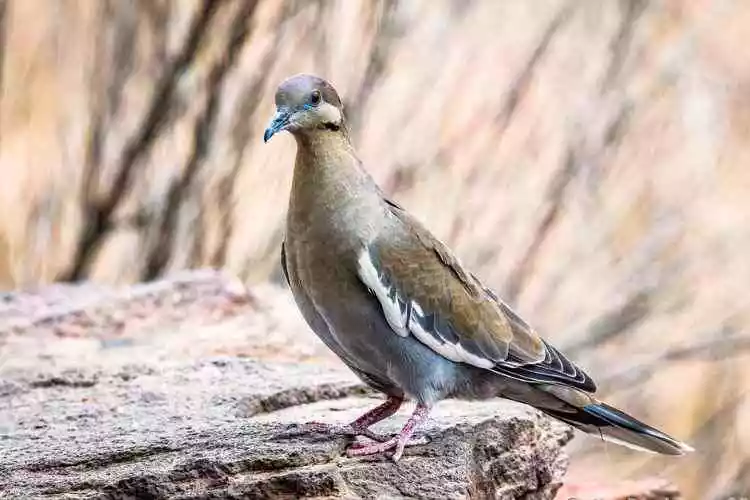
The White-winged Dove is a medium-sized bird found in Florida and other parts of North and Central America. It is also a common species of doves in Colorado.
| Aspect | Information |
|---|---|
| Scientific Name | Zenaida asiatica |
| Common Name | White-winged Dove |
| Status | Least Concern (IUCN) |
| Appearance | Greyish-brown body, white wing patches visible in flight, blue eye ring |
| Size | Length: 29-31 cm (11-12 in); Weight: 150-170 g (5.3-6.0 oz) |
| Habitat | Deserts, woodlands, urban areas, agricultural fields |
| Range | Southwestern United States, Mexico, Central America, Caribbean |
| Diet | Seeds, grains, fruits, nectar |
| Behavior | Ground forager, often seen in flocks |
| Nesting | Nests in trees, shrubs, or on man-made structures; simple platform nest |
| Reproduction | Lays 2 white eggs; 14-day incubation |
| Lifespan | Typically 1.5-2 years in the wild, but can live up to 10 years |
| Threats | Predation, habitat loss, hunting |
| Conservation | Stable population, benefits from urban and suburban environments |
White-winged Doves have greyish-brown feathers with white patches on their wings.
They can be seen in forests, deserts, and cities. They make a distinct cooing sound.
These doves eat seeds, fruits, and sometimes insects. They can be found on the ground or perched on trees or power lines.
In Florida, White-winged Wolves are ordinary and their populations are growing. They are adaptable birds.
The White-winged Dove is a recognizable bird in Florida with greyish-brown feathers and white wing patches. They make a unique cooing sound and can be found in various habitats.
9. White-crowned Pigeon
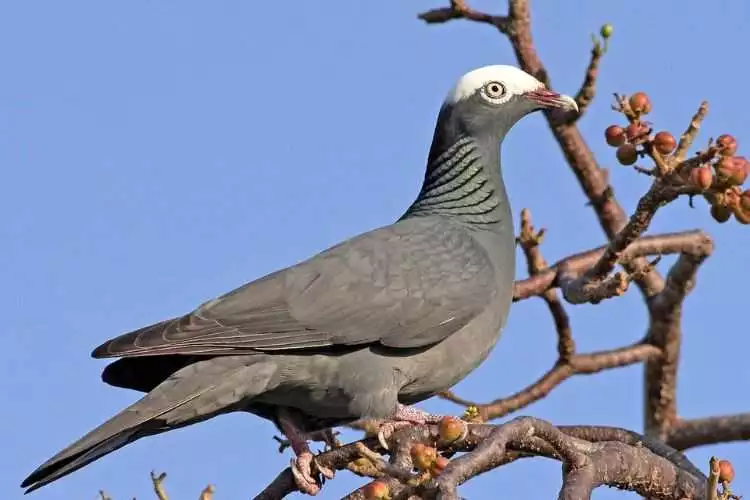
The White-crowned Pigeon is a large pigeon found in the Caribbean and parts of Central and South America.
| Aspect | Information |
|---|---|
| Scientific Name | Patagioenas leucocephala |
| Common Name | White-crowned Pigeon |
| Status | Near Threatened (IUCN) |
| Appearance | Dark grey body, white crown on the head, iridescent neck feathers |
| Size | Length: 29-35 cm (11-14 in); Weight: 230-255 g (8.1-9.0 oz) |
| Habitat | Mangroves, coastal forests, tropical hardwood hammocks |
| Range | Caribbean, Florida Keys, Bahamas, parts of Central America |
| Diet | Fruits, berries, seeds |
| Behavior | Arboreal forager, often seen in flocks |
| Nesting | Nests in trees, often in mangroves; simple platform nest |
| Reproduction | Lays 1-2 white eggs; 13-14 day incubation |
| Lifespan | Typically 4-5 years in the wild |
| Threats | Habitat loss, hunting, predation |
| Conservation | Habitat protection, conservation efforts |
White-crowned Pigeons have a plump body, grey to bluish-grey feathers, and a white crown on their head.
They live in forests and mangroves, where they feed on fruits and berries. They have a unique, low-cooing call and are skilled flyers.
White-crowned Pigeons are found in countries like the Bahamas, Cuba, Jamaica, Belize, Honduras, and parts of South America.
They are at risk due to habitat loss and hunting, as they reproduce slowly and have specific dietary needs.
The White-crowned Pigeon is a large pigeon with a greyish body and a white crown. They live in forests, eat fruits, and have a distinctive call.
They can be found in various countries in the Caribbean and parts of Central and South America.
10. Rock Pigeon
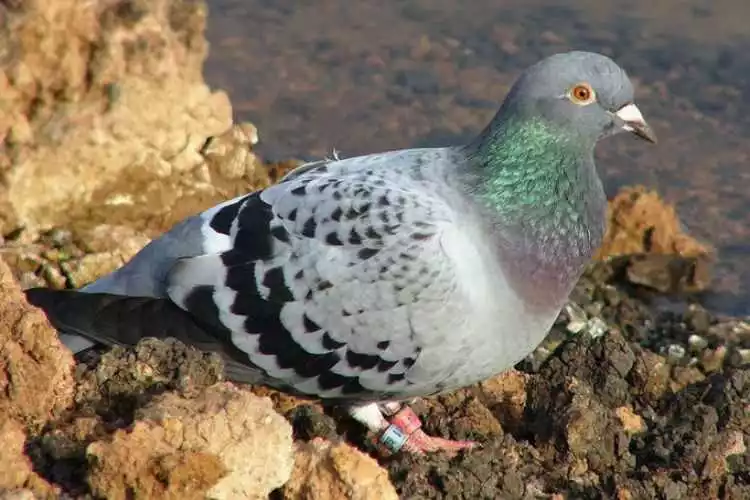
The Rock Pigeon, also called the common pigeon or city pigeon, is a medium-sized bird often seen in cities and urban areas worldwide. Rock doves are also found and are common types of doves in Delaware.
| Aspect | Information |
|---|---|
| Scientific Name | Columba livia |
| Common Name | Rock Pigeon, Common Pigeon |
| Status | Least Concern (IUCN) |
| Appearance | Variable colors; typically grey with iridescent neck feathers, two black wing bars |
| Size | Length: 29-37 cm (11-15 in); Weight: 238-380 g (8.4-13.4 oz) |
| Habitat | Urban areas, cliffs, buildings |
| Range | Worldwide distribution, originally native to Europe, North Africa, and Western Asia |
| Diet | Seeds, grains, human food scraps |
| Behavior | Ground forager, often seen in large flocks |
| Nesting | Nests on buildings, ledges, cliffs; simple platform nest |
| Reproduction | Lays 1-2 white eggs; 17-19 day incubation |
| Lifespan | Typically 3-5 years in the wild, up to 15 years in captivity |
| Threats | Predation, disease, habitat competition |
| Conservation | Stable population, benefits from urban environments |
Rock Pigeons have plump bodies and short legs. They come in various colors like grey, white, brown, and black.
They are adaptable birds and can live in different habitats, but they are most commonly found in cities where they have adjusted to living alongside humans.
Rock Pigeons make cooing sounds and gather in large flocks, especially in places where they are fed by people.
Their diet includes grains, seeds, fruits, and leftover food scraps from humans. They are skilled at finding food in parks, plazas, and streets.
Rock Pigeons reproduce quickly and can build nests on ledges, buildings, and other structures.
People Also Ask (FAQ):
What kind of doves do we have in Florida?
In Florida, you can find several types of doves, including:
Key West quail-dove
Ruddy quail-dove
Mourning Dove
Common Ground-Dove
Eurasian Collared-Dove
Inca Dove
Zenaida Dove
White-winged Dove
White-crowned Pigeon
Rock Pigeon
Is it good to have doves in your yard?
Yes, These birds are very helpful for your yard. These birds eat weed seeds, which is very important for your garden.
What is the difference between a ground dove and a Mourning Dove?
Ground Doves are smaller compared to Mourning Doves. Also, Ground doves like open spaces while Mourning doves like to live in many places including cities.
Why do doves hang around your house?
Doves always find good food sources and very safe nesting sites for their future. So they are hanging around your house. They are often attracted to bird feeders, gardens, or open spaces where they can forage for seeds and grains.
Conclusion
Doves are a beautiful and gentle bird that is often associated with peace and purity. In Florida, there are many different types of doves, each with its unique characteristics. These birds are a welcome sight in any backyard, and they offer a reminder of the beauty of nature.

